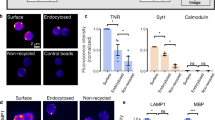Abstract
Extracellular matrix molecules play important roles in neural developmental processes such as axon guidance and synaptogenesis. When development is complete, many of these molecules are down-regulated, however the molecules that remain highly expressed are often involved in modulation of synaptic function. SC1 is an example of an extracellular matrix protein whose expression remains high in the adult rat brain. Confocal microscopy revealed that SC1 demonstrates a punctate pattern in synaptic enriched regions of the cerebral cortex and cerebellum. Higher resolution analysis using electron microscopy indicated that SC1 localizes to synapses, particularly the postsynaptic terminal. SC1 was also detected in perisynaptic glial processes that envelop synapses.




Similar content being viewed by others
References
Nikonenko I, Jourdain P, Muller D (2003) Presynaptic remodeling contributes to activity-dependent synaptogenesis. J Neurosci 23:8498–8505
Kiryushko D, Berezin V, Bock E (2004) Regulators of neurite outgrowth: role of cell adhesion molecules. Ann N Y Acad Sci 1014:140–154
O’Shea KS, Dixit VM (1988) Unique distribution of the extracellular matrix component thrombospondin in the developing mouse embryo. J Cell Biol 107:2737–2748
Rogers SL, Letourneau PC, Pech IV (1989) The role of fibronectin in neural development. Dev Neurosci 11:248–265
Johnston IG, Paladino T, Gurd JW et al (1990) Molecular cloning of SC1: a putative brain extracellular matrix glycoprotein showing partial similarity to osteonectin/BM40/SPARC. Neuron 4:165–176
Hennig A, Krueger R, Mangoura D et al (1992) Chondroitin sulfate proteoglycan expression during neuronal development. Cell Mol Biol 38:585–593
Mendis DB, Shahin S, Gurd JW et al (1994) Developmental expression in the rat cerebellum of SC1, a putative brain extracellular matrix glycoprotein related to SPARC. Brain Res Mol Brain Res 633:197–205
O’Connor LT, Lauterborn JC, Gall CM et al (1994) Localization and alternative splicing of agrin mRNA in adult rat brain: transcripts encoding isoforms that aggregate acetylcholine receptors are not restricted to cholinergic regions. J Neurosci 14:1141–1152
Seidenbecher CI, Richter K, Rauch U et al (1995) Brevican, a chondroitin sulfate proteoglycan of rat brain, occurs as secreted and cell surface glycosylphosphatidylinositol-anchored isoforms. J Biol Chem 270:27206–27212
Girard JP, Springer TA (1995) Cloning from purified high endothelial venule cells of hevin, a close relative of the antiadhesive extracellular matrix protein SPARC. Immunity 2:113–123
Bendik I, Schraml P, Ludwig CU (1998) Characterization of MAST9/Hevin, a SPARC-like protein, that is down-regulated in non-small cell lung cancer. Cancer Res 58:626–629
Oritani K, Kanakura Y, Aoyama K et al (1997) Matrix glycoprotein SC1/ECM2 augments B lymphopoiesis. Blood 90:3404–3413
Brekken RA, Sage EH (2001) SPARC, a matricellular protein: at the crossroads of cell-matrix communication. Matrix Biol 19:816–827
Gongidi V, Ring C, Moody M et al (2004) SPARC-like 1 regulates the terminal phase of radial glia-guided migration in the cerebral cortex. Neuron 41:57–69
McKinnon PJ, McLaughlin SK, Kapsetaki M et al (2000) Extracellular matrix-associated protein Sc1 is not essential for mouse development. Mol Cell Biol 20:656–660
Martinek N, Zou R, Berg M et al (2002) Evolutionary conservation and association of SPARC with the basal lamina in Drosophila. Dev Genes Evol 212:124–133
Brekken RA, Sullivan MM, Workman G et al (2004) Expression and characterization of murine hevin (SC1), a member of the SPARC family of matricellular proteins. J Histochem Cytochem 52:735–748
Araque A, Parpura V, Sanzgiri RP et al (1999) Tripartite synapses: glia, the unacknowledged partner. Trends Neurosci 22:208–215
Peters A, Palay SL, Webster HD (1991) Neuroglial Cells. In: The fine structure of the nervous system: neurons and their supporting cells. Oxford University Press, New York, p 286
Novak U, Kaye AH (2000) Extracellular matrix and the brain: components and function. J Clin Neurosci 7:280–290
Pavlov I, Lauri S, Taira T et al (2004) The role of ECM molecules in activity-dependent synaptic development and plasticity. Birth Defects Res C Embryo Today 72:12–24
Tang L, Hung CP, Schuman EM (1998) A role for the cadherin family of cell adhesion molecules in hippocampal long-term potentiation. Neuron 20:1165–1175
Bukalo O, Schachner M, Dityatev A (2001) Modification of extracellular matrix by enzymatic removal of chondroitin sulfate and by lack of tenascin-R differentially affects several forms of synaptic plasticity in the hippocampus. Neuroscience 104:359–369
Halpain S, Hipolito A, Saffer L (1998) Regulation of F-actin stability in dendritic spines by glutamate receptors and calcineurin. J Neurosci 18:9835–9844
Ross WN, Nakamura T, Watanabe S et al (2005) Synaptically activated ca2+ release from internal stores in CNS neurons. Cell Mol Neurobiol 25:283–295
Yamauchi T (2002) Molecular constituents and phosphorylation-dependent regulation of the post-synaptic density. Mass Spectrom Rev 21:266–286
Stewart MG, Medvedev NI, Popov VI et al (2005) Chemically induced long-term potentiation increases the number of perforated and complex postsynaptic densities but does not alter dendritic spine volume in CA1 of adult mouse hippocampal slices. Eur J Neurosci 21:3368–3378
Volterra A, Meldolesi J (2005) Astrocytes, from brain glue to communication elements: the revolution continues. Nat Rev Neurosci 6:626–640
Acknowledgments
We thank Rong Zou for technical assistance. This work was supported by the National Science and Engineering Research Council of Canada.
Author information
Authors and Affiliations
Corresponding author
Additional information
This work was supported by the National Science and Engineering Research Council of Canada.
Rights and permissions
About this article
Cite this article
Lively, S., Ringuette, M.J. & Brown, I.R. Localization of the Extracellular Matrix Protein SC1 to Synapses in the Adult Rat Brain. Neurochem Res 32, 65–71 (2007). https://doi.org/10.1007/s11064-006-9226-4
Received:
Accepted:
Published:
Issue Date:
DOI: https://doi.org/10.1007/s11064-006-9226-4




